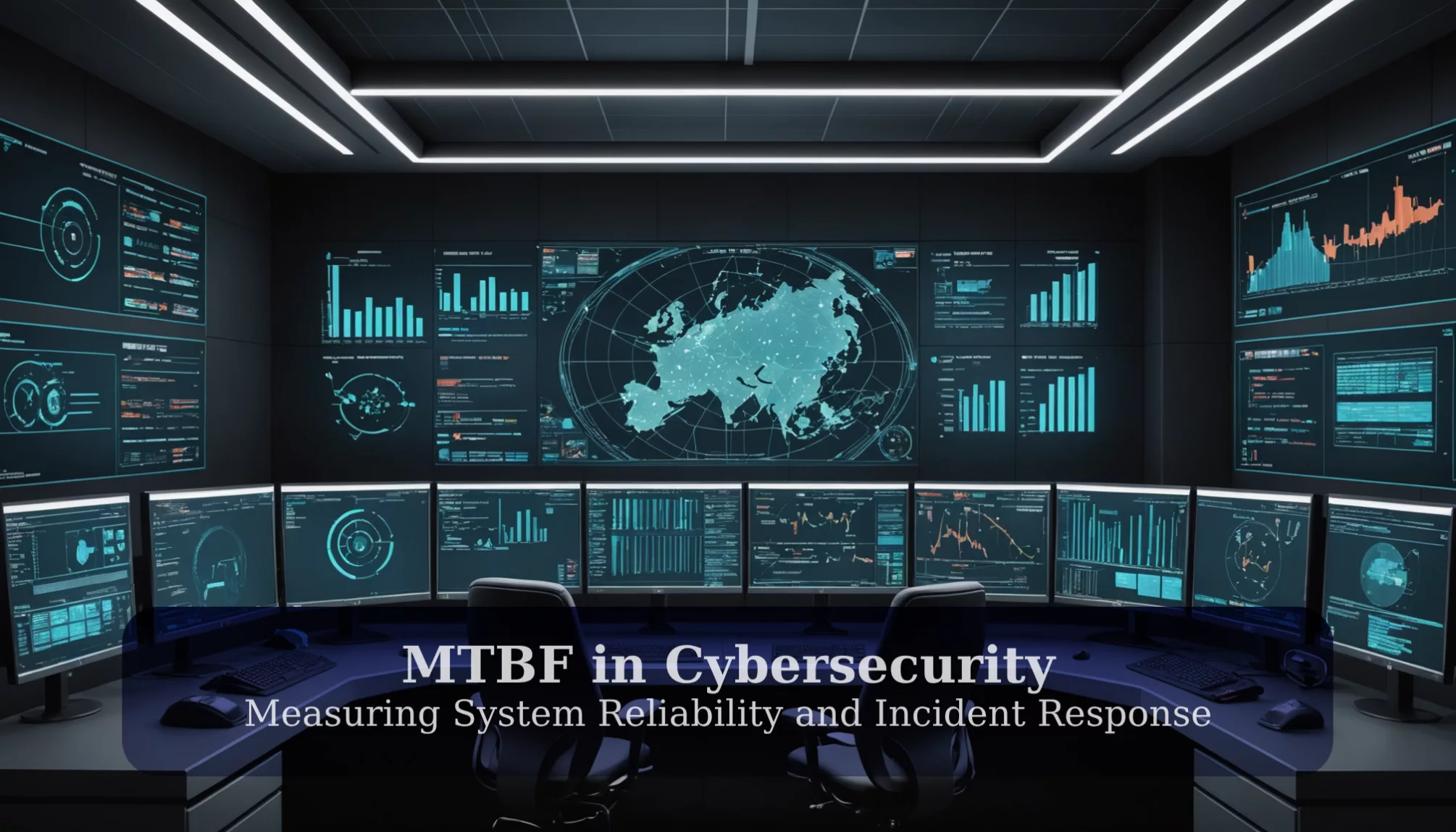In the fast-paced world of cybersecurity, understanding the mtbf in cybersecurity can be the key to keeping systems running smoothly! Imagine a superhero who protects your favorite online games and apps from crashing—MTBF, or Mean Time Between Failures, is just that! This important metric helps tech teams figure out how often systems fail and how to fix them quickly, ensuring you enjoy seamless gaming or browsing experiences without annoying interruptions. By analyzing MTBF, organizations can implement proactive maintenance strategies, significantly reducing downtime and enhancing user satisfaction. For instance, if users are frequently wondering why chrome is running slow, it could indicate underlying system failures that need addressing. By understanding MTBF, tech teams can prioritize these issues, optimizing performance and ensuring that users have a smooth, uninterrupted experience.
But why should you care? If organizations don’t grasp these metrics, they might face severe outages or data breaches that could affect your favorite online activities. In this article, we’ll dive into what MTBF really means, how it stacks up against other metrics like MTTR (Mean Time to Repair) and MTTF (Mean Time to Failure), and why mastering these numbers can enhance cybersecurity measures. Get ready to discover how this knowledge can help keep your digital world safe and sound!
Understanding MTBF in Cybersecurity: A Fundamental System Reliability Metric

Defining Mean Time Between Failures and Its Importance in Security Operations
Mean Time Between Failures (MTBF) measures the average time between two consecutive system failures. This important metric indicates how long a system operates before encountering issues, serving as a critical performance indicator for reliability. A high MTBF signifies a robust infrastructure, helping cybersecurity teams plan preventive maintenance to minimize outages and ensure continuous operation of security systems. (Wikipedia, Prometheus Group)
How MTBF Differs from Mean Time to Failure in Cybersecurity Contexts
MTBF is relevant for repairable systems, while Mean Time to Failure (MTTF) estimates the lifespan of non-repairable components. This distinction aids teams in selecting appropriate metrics for system health and planning maintenance strategies effectively. Understanding these differences allows organizations to implement targeted risk management practices and allocate resources efficiently, ensuring optimal system performance. (Wikipedia)
Calculating and Interpreting MTBF for Critical Security Systems
MTBF is calculated by dividing total operational time by the number of failures. For example, if a system operates for 1,000 hours and experiences five failures, the MTBF is 200 hours. This calculation provides insights into system performance and helps inform maintenance schedules. Regular monitoring of MTBF enables teams to identify trends and make data-driven decisions that enhance overall system reliability.
The Relationship Between MTBF and Key Metric Benchmarks in the Industry
MTBF works alongside other benchmarks like MTTR (Mean Time to Repair) to provide a comprehensive view of system performance. By analyzing these metrics together, organizations can identify areas for improvement and enhance overall operational efficiency. Establishing industry benchmarks helps teams understand their performance relative to competitors, guiding strategic enhancements in system reliability.
Comparing Essential Reliability Metrics: MTBF, MTTR, and MTTF in Cybersecurity

Mean Time to Repair (MTTR): Measuring Recovery Efficiency
MTTR refers to the average time taken to repair a system after a failure occurs. A lower MTTR indicates effective repair processes, leading to reduced downtime and improved service reliability. By closely monitoring MTTR, organizations can refine their incident response strategies, ensuring swift recovery and minimal disruption during cyber incidents.
MTTF vs. MTBF: Understanding the Distinctions and Applications
MTTF measures the expected lifespan of non-repairable systems, while MTBF focuses on repairable systems. Understanding this distinction helps teams prioritize maintenance and resource allocation accordingly. By recognizing when to replace components versus when to repair them, organizations can make informed decisions that extend the life of their assets while minimizing costs.
How These Metrics Collectively Support Incident Management
Together, MTBF, MTTR, and MTTF provide a complete picture of system performance. They assist incident management teams in optimizing resource allocation and planning effective maintenance schedules. An integrated approach using these metrics enhances incident detection, enabling quicker responses to potential threats and reducing the overall impact on operations.
Establishing Baseline Metric Standards for Your Security Infrastructure
Setting baseline standards using metrics like MTBF, MTTR, and MTTF helps organizations gauge system reliability over time. Clear benchmarks guide resource allocation and improve maintenance strategies. By continuously reviewing these standards, teams can adapt to evolving risks and ensure their systems remain robust against potential vulnerabilities.
References:
Optimizing Incident Response Through MTBF Analysis

Using MTBF to Strengthen Cybersecurity Incident Response Protocols
MTBF analysis helps organizations identify potential vulnerabilities in their systems. By measuring the time between failures, teams can design effective incident response protocols that minimize downtime. This proactive approach allows cybersecurity professionals to anticipate issues before they escalate into significant threats.
Leveraging MTTA (Mean Time to Acknowledge) to Improve Initial Response
MTTA measures the time taken to acknowledge a security alert. When combined with MTBF data, it enhances initial response times and reduces the overall impact of incidents. Quick acknowledgment enables teams to mobilize resources efficiently, ensuring that potential threats are addressed promptly.
Practical Applications of MTBF in Security Breach Prevention
Monitoring MTBF allows organizations to anticipate potential failures and schedule proactive maintenance. This practice helps reduce the likelihood of security breaches and enhances overall system performance. By leveraging MTBF insights, teams can implement strategic improvements that bolster their defenses against evolving cyber threats.
Implementing MTBF for Enhanced System Reliability in Security Operations

Best Practices for Monitoring and Improving MTBF in Security Systems
Regular tracking of MTBF data through observability tools ensures that organizations can identify trends early. This proactive approach supports timely maintenance and strengthens overall system reliability. Establishing a culture of continuous monitoring encourages teams to act swiftly on emerging issues before they lead to significant disruptions.
How MTBF Influences Maintenance Planning and Resource Allocation
Understanding MTBF helps teams effectively schedule maintenance and allocate resources. A high MTBF indicates less frequent repairs, allowing for better planning of on-call support. This informed approach minimizes emergency repair situations and optimizes operational efficiency.
Incorporating MTBF into Your Overall Security Reliability Strategy
Integrating MTBF with other performance metrics creates a comprehensive strategy that enhances incident management processes and minimizes downtime. By aligning maintenance planning with reliability metrics, organizations can ensure that their cybersecurity posture remains strong amid evolving threats.
Future Trends: The Evolution of MTBF and Related Metrics in Cybersecurity

How AI and Machine Learning Are Transforming System Reliability Measurement
AI and machine learning technologies are increasingly used to analyze MTBF data. They help organizations predict system failures more accurately, allowing for faster incident detection and response. These advancements not only enhance operational efficiency but also support predictive maintenance strategies that reduce downtime.
Emerging Key Metric Standards for Next-Generation Security Systems
New standards are developing that refine how organizations assess their cybersecurity metrics. These advancements aim to improve incident management processes and enhance overall system resilience. By adopting these emerging standards, teams can better align their practices with industry best practices, ensuring robust defenses against cyber threats.
Conclusion
MTBF is a key metric in cybersecurity that plays a vital role in ensuring system reliability. When used alongside other metrics like MTTR and MTTF, it supports effective maintenance planning and incident management strategies that minimize downtime. By fostering an environment of continuous improvement through regular monitoring and strategic planning, organizations can enhance their overall cybersecurity posture.
FAQs
1. What is the difference between MTBF and MTTR?
MTBF measures the average time between failures in repairable systems, while MTTR measures the average time taken to repair those systems after a failure occurs. Together, they provide valuable insights into system reliability.
2. How can MTBF improve cybersecurity strategies?
MTBF offers insights into operational performance, helping teams plan preventive maintenance and reduce unexpected outages. This proactive approach leads to enhanced cybersecurity resilience.
3. What role does MTTA play in incident response?
MTTA measures how quickly alerts are detected and acknowledged. A fast MTTA improves initial response times, minimizing the impact of security incidents on system performance.

